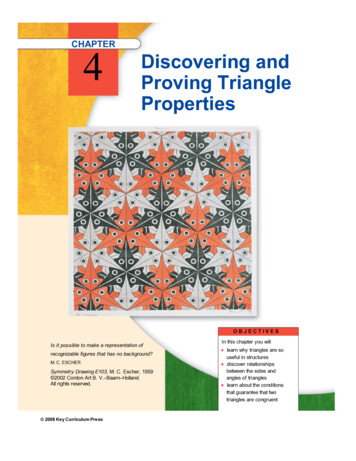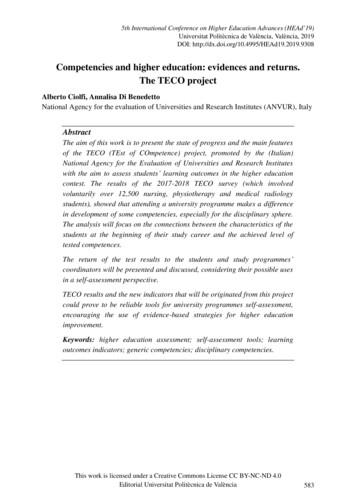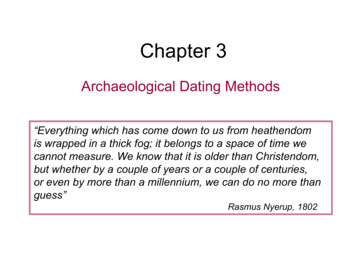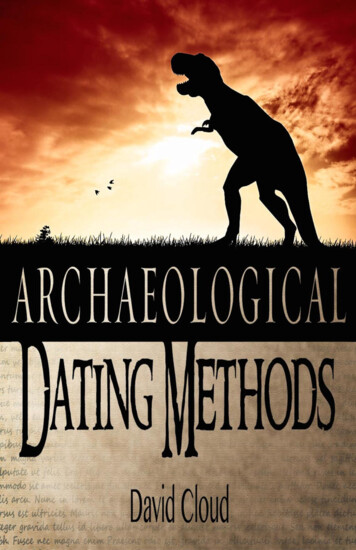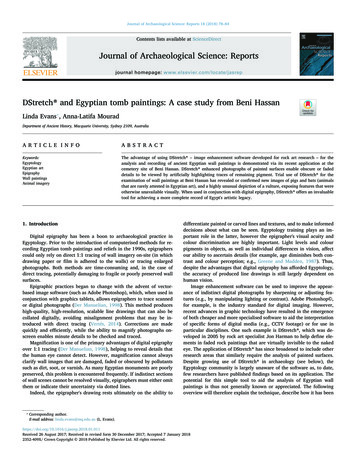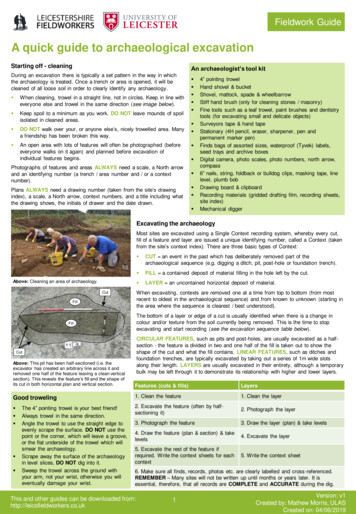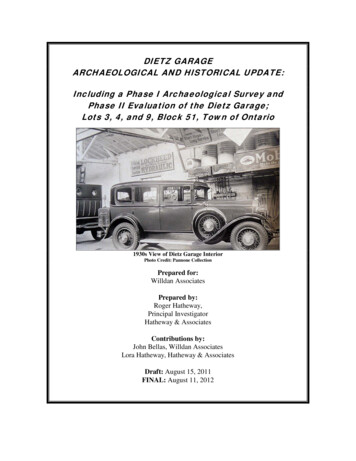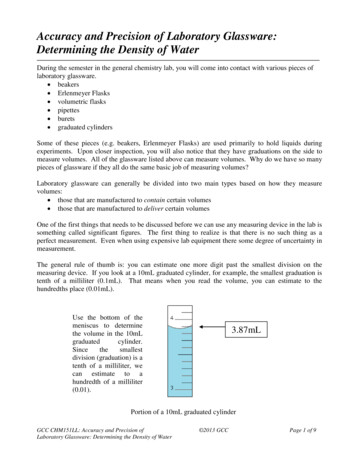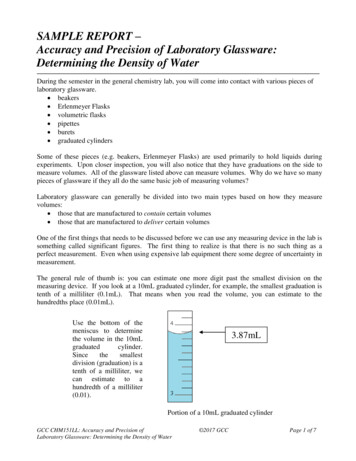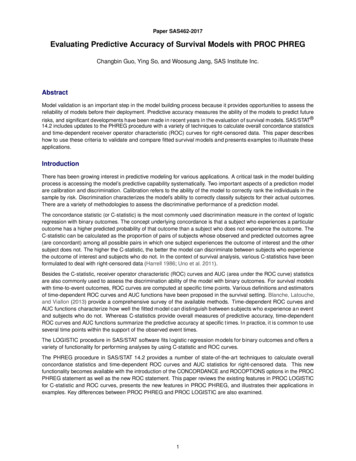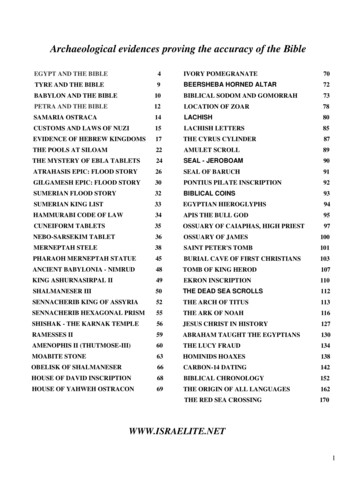
Transcription
Archaeological evidences proving the accuracy of the BibleEGYPT AND THE BIBLE4IVORY POMEGRANATE70TYRE AND THE BIBLE9BEERSHEBA HORNED ALTAR72BABYLON AND THE BIBLE10BIBLICAL SODOM AND GOMORRAH73PETRA AND THE BIBLE12LOCATION OF ZOAR78SAMARIA OSTRACA14LACHISH80CUSTOMS AND LAWS OF NUZI15LACHISH LETTERS85EVIDENCE OF HEBREW KINGDOMS17THE CYRUS CYLINDER87THE POOLS AT SILOAM22AMULET SCROLL89THE MYSTERY OF EBLA TABLETS24SEAL - JEROBOAM90ATRAHASIS EPIC: FLOOD STORY26SEAL OF BARUCH91GILGAMESH EPIC: FLOOD STORY30PONTIUS PILATE INSCRIPTION92SUMERIAN FLOOD STORY32BIBLICAL COINS93SUMERIAN KING LIST33EGYPTIAN HIEROGLYPHS94HAMMURABI CODE OF LAW34APIS THE BULL GOD95CUNEIFORM TABLETS35OSSUARY OF CAIAPHAS, HIGH PRIEST97NEBO-SARSEKIM TABLET36OSSUARY OF JAMES100MERNEPTAH STELE38SAINT PETER'S TOMB101PHARAOH MERNEPTAH STATUE45BURIAL CAVE OF FIRST CHRISTIANS103ANCIENT BABYLONIA - NIMRUD48TOMB OF KING HEROD107KING ASHURNASIRPAL II49EKRON INSCRIPTION110SHALMANESER III50THE DEAD SEA SCROLLS112SENNACHERIB KING OF ASSYRIA52THE ARCH OF TITUS113SENNACHERIB HEXAGONAL PRISM55THE ARK OF NOAH116SHISHAK - THE KARNAK TEMPLE56JESUS CHRIST IN HISTORY127RAMESSES II59ABRAHAM TAUGHT THE EGYPTIANS130AMENOPHIS II (THUTMOSE-III)60THE LUCY FRAUD134MOABITE STONE63HOMINIDS HOAXES138OBELISK OF SHALMANESER66CARBON-14 DATING142HOUSE OF DAVID INSCRIPTION68BIBLICAL CHRONOLOGY152HOUSE OF YAHWEH OSTRACON69THE ORIGIN OF ALL LANGUAGES162THE RED SEA CROSSING170WWW.ISRAELITE.NET1
Biblical Archaeology: Ancient CivilizationBiblical archaeology really begins with the Sumerian civilization of about 2500 BC. To date,numerous sites and artifacts have been uncovered that reveal a great deal about the ancientMesopotamian culture. One of the most dramatic finds is the Sumerian King List, which dates toapproximately 2100 BC. This collection of clay tablets and prisms is most exciting because itdivides the Sumerian kings into two categories; those who reigned before the "great flood" andthose who reigned after it. The lists are also dramatic because they include the ages of the kingsbefore and after the "great flood," which show the same phenomenal life span changes mentionedin the Bible. Actually, records of a global flood are found throughout most ancient cultures. Forinstance, the Epic of Gilgamesh from the ancient Babylonians contains an extensive flood story.Discovered on clay tablets in locations such as Ninevah and Megiddo, the Epic even includes ahero who built a great ship, filled it with animals, and used birds to see if the water had receded(see Genesis 7-8). What has been discovered in biblical lands is strongly supportive of the Bible.To date, over 25,000 sites in biblical lands have been discovered that verify the accuracy of theBible.Biblical Archaeology: Ancient Law & CultureBiblical archaeology continues with the great military civilizations of ancient Mesopotamia andtheir ultimate impact on law and culture throughout the region. One significant find is the LawCode of Hammurabi, which is a seven foot tall, black diorite carving containing about 300 laws ofBabylon's King Hammurabi (Hammurapi). Dated to about 1750 BC, the Law Code contains manycivil laws that are similar to those found in the first five books of the Bible. Another find at theancient city of Nuzi near the Tigris River uncovered approximately 20,000 clay tablets. Datedbetween 1500 and 1400 BC, these cuneiform texts explain the culture and customs of the time,many of which are similar to those found in the early books of the Bible.Biblical Archaeology: Ancient IsraelBiblical archaeology then turns to the evidence for the early Israelites. The Merneptah Stele (alsoknown as the Israel Stele) is an upright stone slab measuring over seven feet tall that containscarved hieroglyphic text dating to approximately 1230 BC. The Egyptian stele describes themilitary victories of Pharaoh Merneptah and includes the earliest mention of "Israel" outside theBible. Although the specific battles covered by the stele are not included in the Bible, the steleestablishes extra-biblical evidence that the Israelites were already living as a people in ancientCanaan by 1230 BC. In addition to the Stele, a large wall picture was discovered in the greatKarnak Temple of Luxor (ancient Thebes), which shows battle scenes between the Egyptiansand Israelites. These scenes have also been attributed to Pharaoh Merneptah and date toapproximately 1209 BC. The Karnak Temple also contains records of Pharaoh Shishak's militaryvictories about 280 years later. Specifically, the Shishak Relief depicts Egypt's victory over KingRehoboam in about 925 BC, when Solomon's Temple in Judah was plundered. This is the exactevent mentioned in 1 Kings 14 and 2 Chronicles 12.Outside Egypt, we also discover a wealth of evidence for the early Israelites. The Moabite Stone(Mesha Stele) is a three-foot stone slab discovered near Dibon ,East of the Dead Sea, thatdescribes the reign of Mesha, King of Moab, around 850 BC. According to Genesis 19, theMoabites were neighbors of the Israelites. The stele covers victories by King Omri and Ahab ofIsrael against Moab, and Mesha's later victories on behalf of Moab against King Ahab's2
descendants (2 Kings 3). The Black Obelisk of Shalmaneser is a seven-foot, four-sided pillar ofbasalt that describes the victories of King Shalmaneser III of Assyria. Dated to about 841 BC, theObelisk was discovered in the ancient palace of Nimrud and shows Israel's King Jehu kneelingbefore the Assyrian king in humble tribute (see 2 Kings 9-10).Biblical Archaeology: The House of David and Solomon's TempleBiblical archaeology covering ancient Israeli kings and culture received a huge lift in 1994 whenarchaeologists discovered a stone inscription at the ancient city of Dan, which refers to the"House of David." The House of David Inscription (Tel Dan Inscription) is important because it'sthe first ancient reference to King David outside the Bible. Specifically, the stone is a victorypillar of a King in Damascus dated about 250 years after David's reign, which mentions a "king ofIsrael" (probably Joram, son of Ahab) and a king of the "House of David" (probably Ahaziah ofJudah). Another important find is the House of Yahweh Ostracon, which is a pottery shard datedto about 800 BC that contains a written receipt for a donation of silver shekels to Solomon'sTemple. Written approximately 130 years after the completion of the Temple, this appears to bethe earliest mention of Solomon's Temple outside the Bible.3
Egypt and the BibleThe Bible stories concerning therelationship of God's people with Egypthave been subject to much ridicule. Criticsregard Biblical stories, such as theaccounts of Joseph and the Exodus,as mythology.The stones of archaeology were silentwitnesses to the dramas of the past, and itwas only after 1799, when the RosettaStone was discovered, that the ancientrecords could be deciphered. It took Jean-François Champollion 20 years to decipher theancient hieroglyphics from the Rosetta Stone. The Stone was unique in that three languageswere inscribed upon it, each telling the same story. The science of archaeology is thus afledgling science, and most of its treasures have only been subject to scrutiny in the last century.Today it is possible to not only read hieroglyphics, but also the ancient cuneiform writings.Astoundingly, the ancient relics have succeeded in silencing many of the Biblical critics. Theharmony between Scripture and archaeological findings has shed new light upon the debate.Concerning the story of Joseph, it is known that the Semitic Hyksos overthrew the Egyptiandynasties from the year 1780 BC to 1545 BC, aperiod of just over a quarter of a century. Duringthis time, it would have been possible for a Semiteto reach the position of prestige occupied byJoseph. In recent times, frescoes have been foundin Egyptian tombs depicting fat and thin cows, andinscriptions have been found referring to sevenlean and seven opulent years, making this Biblicalstory more than just a myth. One of the mostexciting stories in Scripture, however, is theExodus.According to Biblical chronology, Moses was bornin 1530 BC, during the reign of Tutmoses I, whoruled from 1532 to 1508 BC. Tutmoses I was thethird pharaoh of the 18th dynasty. The first pharoahwas Amoses 1570 to 1553 BC, followed by Amenhotep 1553 to 1532 BC, who was the father ofTutmoses I. This is the pharaoh who issued the decree that all the sons born to the Israeliteswere to be thrown into the river, but that girls were permitted to live (Exodus 1:22).4
Aaron, the brother of Moses, was born in 1533 BC, prior to the reign of Tutmoses I, and he hadthus escaped the vicious decree. According to Biblical chronology, Moses fled Egypt 40 yearsafter his birth in 1490 BC (Remember, we have to calculate backwards, as we are dealing withthe time before Christ). Exodus 2:15 tells us about Pharaoh's reaction:"When Pharaoh heard of this, he tried to kill Moses, but Moses fled from Pharaoh, and went tolive in Midian" (NIV).It was here, in Midian of Sinai, that the Lord revealed Himself toMoses. Two pharaohs reigned simultaneously during the exile ofMoses. Tutmoses I, who issued the decree to kill the newborn sonsof the Israelites, was the father of Hatshepsut, the princess who isthe most likely candidate for having found Moses in the Nile. It isprobable that Moses grew up as a foster child in the house ofPharaoh. Tutmoses I had no sons, and, upon his death in 1508 BC,Moses could have become the pharaoh, but he declined. Acts 7:20tells us, "Moses was educated in all the wisdom of the Egyptians,and was powerful in speech and action."In Hebrews 11:24,we are told, "By faithMoses, when he hadgrown up, refused tobe known as the sonofPharaoh'sdaughter."After Moses' refusal,Tutmoses II (the husband of Hatshepsut) becamepharaoh, but he only ruled from 1508 to 1504 BC,a period of just four years. Again, Moses couldhave become pharaoh, but again he refused.Hatshepsut herself became the next pharaoh.Her mortuary temple is at Deir el Bahri, and sheruled Egypt from 1504 to 1482 BC; a total of 22years. The illegitimate son of Hatshepsut'shusband became co-regent together with her. Hewas Tutmoses III, who was favoured by theEgyptian priesthood.The story of Hatshepsut is a sad story. In 1488,six years prior to her death, all official records ofHatshepsut ceased. Her royal wall paintings on5
the walls of her mortuary temple at Deir el Bahri were defaced, and her statues were destroyed.To this day, only a few small busts have been found. Such drastic action was only taken ifpharaohs were disloyal to Egyptian deities. It is probable that Hatshepsut adopted the Hebrewreligion in 1488, when Egyptian documentation about her ceased. Moses at this time wasalready in exile, having fled before the wrath of Tutmoses III, who enjoyed the support of theEgyptian priesthood.Moses heard about the death of Hatshepsutwhile he was in exile, and her death is recordedin his writings. Exodus 2:23 states, "During thatlong period, the king of Egypt died." The soleruler in Egypt was now Tutmoses III, and withHatshepsut out of the way, and the protectionshe probably afforded the Israelites no longeravailable, Tutmoses suppressed them in a mostcruel fashion."The Israelites groaned in their slavery and criedout, and their cry for help because of their slaverywent up to God. God heard their groaningsand.looked on the Israelites and was concerned about them" (Exodus 2:23-25).The return of Moses and his fear for Pharaoh is now understandable, particularly since thesame pharaoh that induced him to flee became the sole ruler in Egypt.Tutmoses III was one of the greatest pharaohs in history. He was known as the Napoleon ofEgypt. He ruled until 1450 BC, which, according to the chronology in 1 Kings 6:1, is the year ofthe Exodus. According to the Bible, the Exodus took place on March 17, 1450 BC. The precisedates of the Passover and the Exodus are recorded in the Scriptures. The Bible tells us that thepharaoh then ruling (Tutmoses III) followed the Israelites through the Red Sea, and that he waskilled in the process. The biography of Tutmoses III, written by Amenemhab says, "Lo, the kingcompleted his lifetime of many years, splendid in valour, in might and triumph: from year 1 to54."1504 to 1450, a reign of 54 years, bringsus precisely to the date of the Exodus.Amenemhab mentions the month andthe day of his death:"The last day of the third month of thesecond season. He mounted to heaven,he joined the sun: the divine limbsmingled with him who begot him."6
According to the Egyptologist James Breasted, this translates to the March 17, 1450 BC. Amummy of Tutmoses III in the Cairo museum was analysed by two Egyptologists, Harris andWeeks, in 1973 and found to be a mummy of a young man, whereas Tutmoses III must havebeen at least 80.Egyptians had a way of disguising their embarrassments.The pharaoh was probably never recovered from the RedSea, and to hide this fact, a fake mummy was put in hisplace. There is more circumstantial evidence from the 18thdynasty to support this argument. Tutmoses III co-reignedwith his son, Amenhotep II (after the death of Hatshepsut),and Amenhotep II was not in Egypt at the time of theExodus, but in Syro-Palestine suppressing an uprisingwith most of the Egyptian army. According to Egyptianwritings, he returned in June 1450 BC, when he apparentlydefaced many Egyptian monuments. This act needs anexplanation. The Bible tells us that all the first-born in Egyptdied in the last plague. On returning to Egypt, he wouldhave found not only the Israelites gone, but he would havealso found his father dead, and his first-born son killed inthe plague. One can now understand the emotion felt byAmenhotep that caused such a violent outburst.Thenextpharaoh to rule was Tutmoses IV, who was thesecond born son of Amenhotep II. According tosuccession rights, the first-born should havebecome pharaoh, but he died. To explain thisapparen
archaeological evidences proving the accuracy of the bible egypt and the bible 4 tyre and the bible 9 babylon and the bible 10 petra and the bible 12 samaria ostraca 14 customs and laws of nuzi 15 evidence of hebrew kingdoms 17 the pools at siloam 22 the mystery of ebla tablets 24 atrahasis epic: flood story 26 gilgamesh epic: flood story 30 sumerian flood story 32 sumerian king list 33 .
